All in favor of improving meeting procedures, say Aye!
Trying to keep your in-person and virtual meetings on track and running smoothly? You need Robert's Rules of Order! These rules for conducting meetings have stood the test of time as the gold standard for practical and effective procedure in group settings like corporate and nonprofit boards, councils, and more. And there's no better way to learn the latest version of the rules than with Robert's Rules For Dummies.
This handy guide demystifies the Rules and offers readers a practical roadmap to applying efficient procedures to everything from conducting online and in-person meetings to voting by email. It also:
- Contains brand-new, updated content on the latest 12th Edition of Robert’s Rules
- Offers sample meeting agendas, minutes, scripts, and other material to show you how the pros keep meeting records
- Walks you through the basic—and not so basic—ways to nominate and elect officers and directors in organizations
Ideal for board members, convention delegates, business owners, nonprofit executives, and anyone else trying to maintain an orderly flow of business—online or in person—Robert’s Rules For Dummies is a need-to-read resource that will make you wonder how you ever survived without it.









